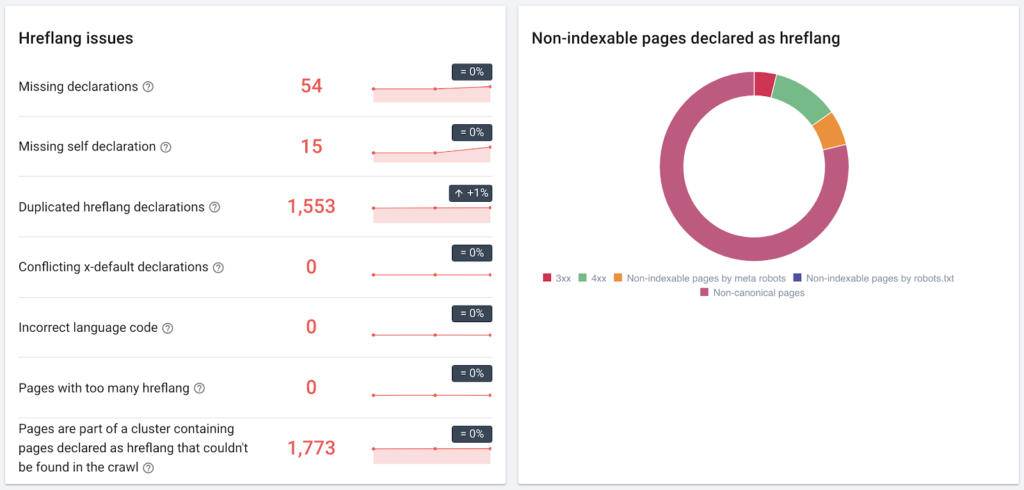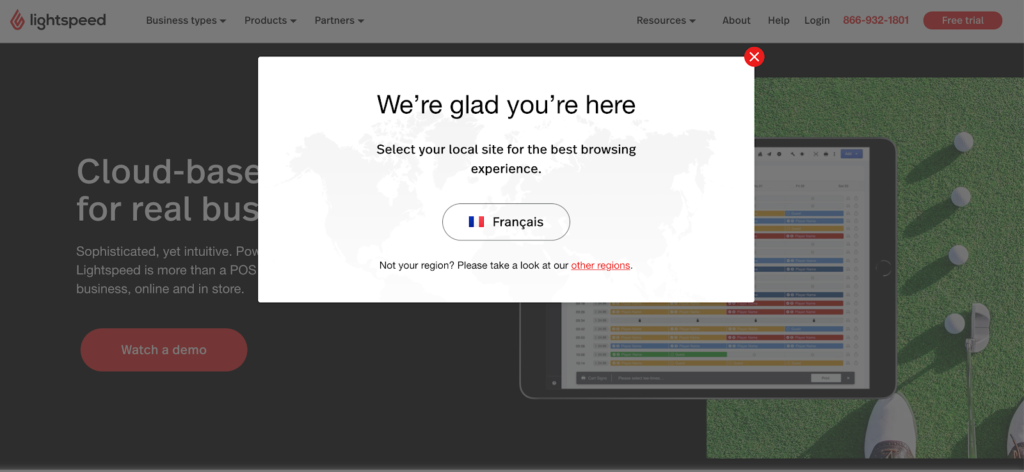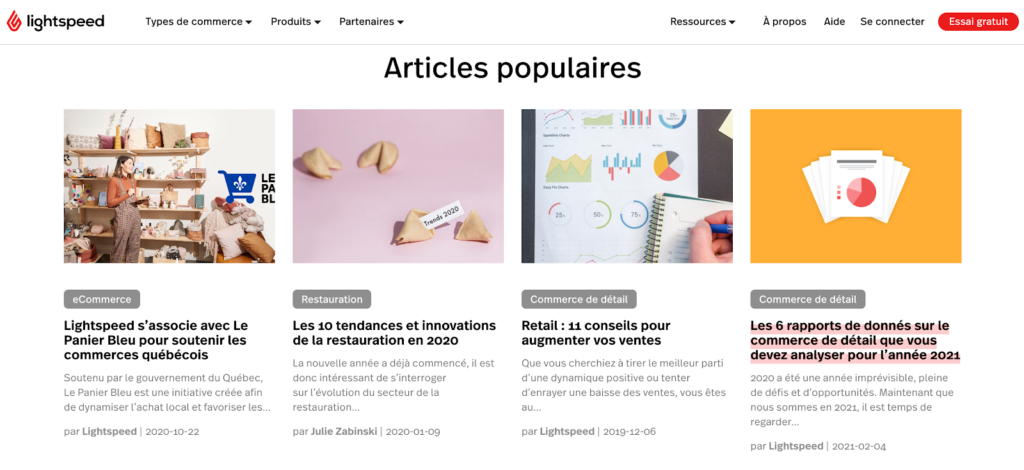We spoke with Minh-Thy Nguyen, SEO Specialist at Lightspeed, as part of our project to share what Oncrawl users are doing in SEO in their day-to-day jobs.
Minh-Thy Nguyen from content work at an agency to technical SEO
“My ambition in the SEO world is to ramp up on my technical skills.”
Minh-Thy got her start working for a digital marketing agency as part of the SEO department. Despite her background in web content creation, she quickly gained skills in SEO, general digital marketing, and customer satisfaction.

Minh-Thy: I was definitely curious about the actual implementation of our recommendations. I think that when you’re in an agency, it’s relatively easy to come up with recommendations that you provide to the client, but you’re kind of missing that close interaction that you have with the content team or with the developers. Since I’ve been at Lightspeed, I’m definitely seeing more how my recommendations come to life. I really cover the project from A to Z, working closely with the teams making sure that it can be implemented.
Lightspeed is a point-of-sale and e-commerce software provider based in Montreal, Quebec, Canada. It was founded in 2005 by Dax Dasilva who also serves as the CEO of the company. It offers its services to 100,000+ retail, hospitality, and golf businesses, across 100 countries.
What it’s like working on SEO in-house and at home
“Working with Oncrawl as an in-house SEO has helped me understand how to better leverage internal links.”
Moving from an agency to an in-house position can provide opportunities to learn and use new skills on a regular basis. Minh-Thy wanted to see her recommendations implemented and follow-up on long-term projects. Being in-house also allows her to develop her knowledge of the market and the brand.
Oncrawl: How has working in-house changed your approach to SEO?
Minh-Thy: I’m learning a lot about how websites really work on the back end, the constraints that we’re facing when it comes to the CMS, and not just how recommendations look on the website.
I’ve also been working with Oncrawl more since I’ve been at Lightspeed. It’s definitely helped me understand better when it comes to how to properly leverage internal links and to see my website through different views. I mean, for instance, through a Google Analytics view, or more from a Googlebot standpoint, or how a user would interact with it.
Oncrawl: You mentioned you’re working from home, like so many of us these days. Has that affected how you do SEO?
Minh-Thy: It pushes me to be even even more independent, and to search for things by myself. I have had to try to step away from just going up to the dev, when I could do some research on my own instead. Then I can come back to the dev with what I learned and say, “Hey, this is what I found out. Is this something that we can do? Or is this something that is possible?”
Technical SEO for an international portfolio of websites
“Having a lot of different websites across the world is a big project, in terms of managing Lightspeed’s global presence.”
Running international websites always implies multiple challenges: offering content in more than one language, targeting users in different countries… You need to help users (and Google) find the right version of your website. Lightspeed uses different CMS for its sites and blogs, which complicates some projects and impacts user experience.
Implementing hreflang tags for international sites
“I’m coming to realize that, just because we have an SEO solution that seems very easy, that doesn’t mean that it is as easy as you think.”
Oncrawl: You provide services in over 100 countries. How many domains do you maintain to cover that geographical area? Do you mainly focus on ranking in Google as a primary search engine in all of your markets?
Minh-Thy: In terms of our domains, we have 13 separate domains. At Lightspeed, it’s interesting to look at how our websites work together, and then which ones are working separately and independently. We have a very strong presence in Europe. We recently acquired a new company in Australia. So I would say that looking at other search engines would be definitely something to discuss, regarding the APAC market. It’s interesting to look at other algorithms that we can focus on.
Oncrawl: Does managing all 13 separate domains affect how you use hreflang?
Minh-Thy: We use WordPress for all of our websites. But our blog is on a different CMS or database. So one of the big projects that we’ve been working on was regarding our hreflang tags.
The way that we used to work was that we provided the tags through our sitemap. But then we noticed that we’ve been seeing issues and so we wanted to change how we provided them. We wanted to put them in our header meta data. We noticed that with our blog, unfortunately, that wouldn’t work.

First steps in implementing hreflang tags in header meta data, analyzed in Oncrawl
I’m coming to realize that, just because we have a simple solution in mind, or a recommendation that seems very easy, that doesn’t mean that it is as easy as you think. There are more steps that need to be covered, or there’s a lot more coding that needs to be done. In this case, it’s been more challenging than I was expecting.
Indexing the right site for the market: a UX question
“Our main technical SEO challenge has been in terms of user experience when getting the right site indexed.”
Minh-Thy: The most recent website that we launched was in France, for example. We have our .com version, and a French Canadian version as well. What we’ll notice is that the French Canadian version would often appear in Google France. I think it’s because the authority of our .com domain was much stronger than our .fr website. But the products that we offer are not the same in France versus here in Canada.
This is what led to us wondering, “okay, what would be another alternative to signal the right site to show in Google France? Or how could we further improve our hreflang tags?”
For us, the main problem is that we’re definitely seeing a lot of issues in terms of user journey. And it was just through our monitoring and rankings. I’m using keyword.com, and I noticed that in France, we were seeing the pages that we’re ranking for our brand name, and we’re noticing that the .com website is appearing first and our .fr was appearing second or third or even fourth. So I was thinking, this is going to become a problem.
I think we implemented the hreflang in the header metas last winter, back when I was still in the office. So it was before the pandemic. That seemed to help, but then we started to realize that we had a different behavior with the blogs.
This is the conversation we’re having with the dev team and wondering, is there a workaround that works in our CSM and has results for SEO?

Lightspeed website with language preference
Localizing content in new markets
“We’re becoming more present in a lot of different countries, and we’re not able to properly localize each content”
Content localization is necessary to conquer new markets. With new acquisitions in multiple countries, Lightspeed has to adapt its SEO strategy.
Minh-Thy: We’ve started acquiring more companies, and we’re becoming more present in a lot of different countries. And this posed a problem with the blogs: we’re not able to properly localize each content. Recently, we’ve started talking more about questions like, “How can we fix this type of issue?”
How can we localize our content, but without necessarily changing the hreflang? We don’t want to duplicate the content, because then we’re kind of going back to our previous situation. At the moment, we’re just trying to weigh the different outcomes and see what would make most sense.
Oncrawl: That would create a lot of content to manage.
Minh-Thy: Yes, yes, definitely. It’s a lot of content.
Fortunately, I’m definitely not the only one on this. In terms of the SEO team, we’re spread out around the world. I mainly manage North America.

Lightspeed’s French blog
What to do with ranking content during website migrations and mergers
“Because there’s so much that rides on how and what we migrate from websites of companies we acquire, it’s important to evaluate and monitor before we make a decision.”
With a fast pace of acquisitions, Lightspeed has to handle a lot of migrations and this situation creates new challenges for SEO and branding. Minh-Thy wanted to be sure that website authority is transferred to Lightspeed, but also to use the knowledge of their market to improve localization.
Minh-Thy: Our global presence has been growing really fast. I would say, regarding mergers and acquisitions, we’re maybe acquiring a company every quarter. So we’ve been dealing with a lot of website migrations: from planning them, to mapping their website to our Lightspeed website and trying to incorporate their content.
I think one of the biggest challenges that we’re having is whether or not it’s a good idea to keep just a skeleton website in place: just the homepage of the website, saying they’ll be acquired.
For SEO, we feel like it doesn’t make sense. It’s not ideal, because then we can’t properly transfer all of that website authority on to ours. However, I think from a branding standpoint, it would make more sense to keep just that homepage so that we can provide news and information as to the fact that we’ve acquired a new company. This is a position some of our managers and higher ups are taking. It’s definitely a tough conversation to have.
Minh-Thy: So let me give an example. We acquired a company in Australia, then one in Germany, and recently we acquired two more in the States. There’s been a lot of work to do regarding integrating all of these sites into one brand, and then creating a unified Lightspeed image. I would say our SEO choices during migrations really do have an impact on our global presence.
On the other hand, I think the positive outcome of this is that we also have brands that know their market very well, that know their local market. So I think this is something there: for localization, it helps to be able to work with them closely.
Oncrawl: When you start a new migration, do you say, “Oh no, not this again?” Or do you have a tip or any suggestions for others in the same situation?
Minh-Thy: Yeah, I’d say not to rush things and to assess before you make a decision.
For instance, what we were just saying about whether or not we should keep the homepage. I feel like it’s important to first assess the website itself. Then we can see, in terms of its authority compared to ours, if it makes sense from a branding perspective, to keep it as it is. Or maybe we will want to gain all of that SEO link juice and have it properly migrated to ours.
Takeaways from chatting with Minh-Thy Nguyen
This conversation with Minh-Thy shows us that managing a portfolio of international websites implies multiple challenges. Lightspeed has to adapt its marketing and SEO strategy to their local markets.
First, it’s essential to realize the complexity of managing different sites and their infrastructure for different local markets. It is necessary to take into account the particularities of each one in order to adapt the steps of the project.
Next, with an important external acquisition strategy, it is important to anticipate the needs: how to manage the migration of websites, how to best localize the content… These decisions can strongly impact not only SEO but also brand image.
Finally, the key is not to rush and to plan for potential difficulties. Managing multiple sites in different countries makes the deployment of projects longer and more laborious. It is therefore necessary to anticipate and keep in mind not only SEO issues but also the general branding. An international brand is not managed in the same way as a local brand, and SEO must also adapt to this particularity.
We’d like to reiterate our thanks to Minh-Thy Nguyen for taking the time to talk with us and share her views on the day-to-day issues faced by SEOs everywhere.

